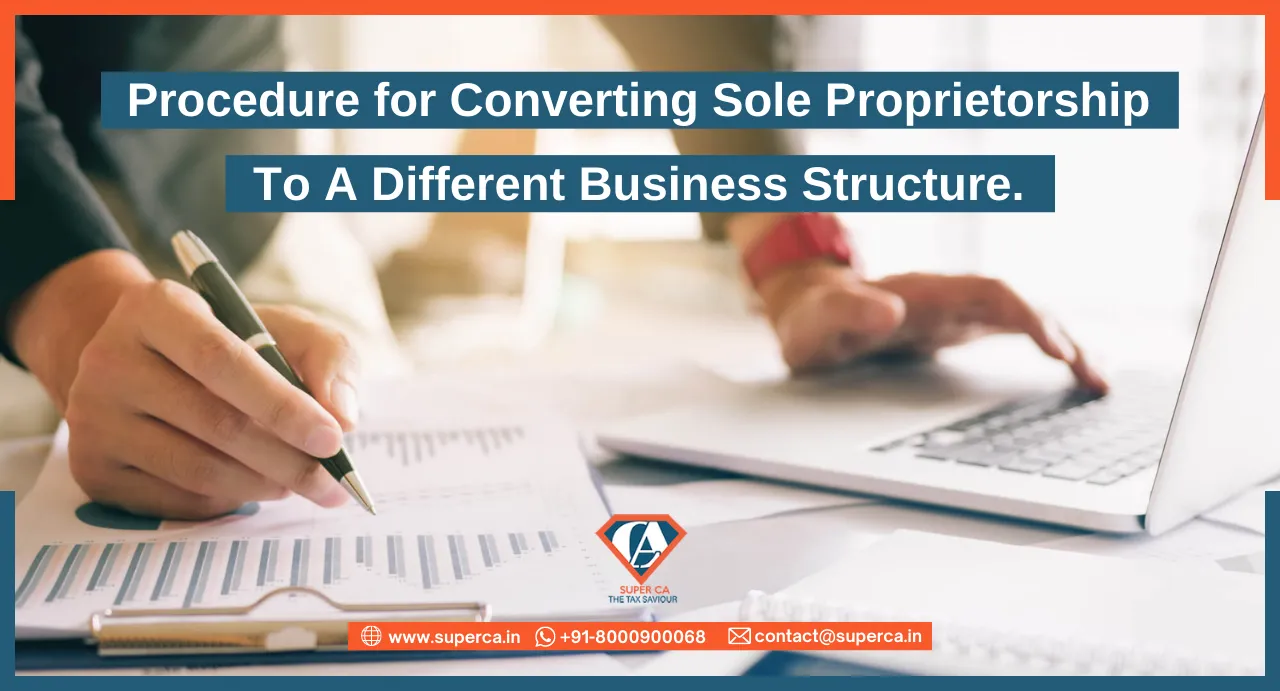Procedure for Converting Sole Proprietorship To A Different Business Structure
- Posted By SuperCA
- On 05 May

What is Sole Proprietorship?
Sole proprietorship holds many benefits as compared to other entities for those people who are starting a new business with comparatively less risks. It is best for small and medium businesses or for professionals who do not want to be associated with others.
However, it isn't easy to raise capital to scale the business in Sole proprietorship . Sole proprietors have limited avenues for raising capital such as Investment of own savings, taking out loans to support the business, advances from commercial banks or borrowing from finance companies, no way of raising Equity Capital, Unlimited Liability, Difficulty in Obtaining Funds, Higher Tax Incidence and a few more.
Hence, it’s difficult to build a big business as a single person as Sole Proprietorship is seen to hamper growth with time. So, if one is looking to expand his/her business then it is advisable that this structure should be converted to another form once achieving growth to a sustainable level. It is very common for sole proprietors to convert their business into partnerships and private limited companies and others after business starts growing. The conversion process is possible and you can always choose to do so. But due to a ton of information scattered online, many people get confused. In this article we’ll discuss how you can convert your sole proprietorship business to a legal entity.
Conversion of Sole Proprietorship to Pvt. Ltd
Prerequisite
The proprietor should ensure compliance with the following requirements before beginning the conversion:
- The owner of the sole proprietorship needs to be one of the directors of the limited company.
- A minimum of two directors are a must . One of them can be the proprietor himself, and the other can be any individual.
- The directors need to have their Director Identification Number (DIN) as a prerequisite to incorporation.
- The company needs minimum of two shareholders, and they can be the same as the directors.
- Minimum authorized capital of 1 Lakh rupees.
The procedure to form a private limited company from a business with sole proprietorship registration is to first form the private limited company and then take over the sole proprietorship through a Memorandum Of Association (MoA) and transfer all benefits and liabilities to the limited company.
Important Conditions while Conversion
- A takeover agreement or sale agreement needs to be entered into between the sole proprietor and the company.
- All the assets and liabilities of the sole proprietorship must be transferred to the new Pvt. Ltd. company.
- The shareholding of the proprietor should not be less than 50% of the voting power, and the same must continue to be held for a period of 5 years from the date of the succession.
- The sole proprietor does not receive any benefit or consideration, directly or indirectly, in any form or manner, other than by way of allotment of shares in the company.
Converting Sole Proprietorship to One Person Company (OPC)
One person company is an improved and better form of a sole proprietorship firm and thus conversion of sole proprietorship into One Person Company is a good business decision.
Prerequisites
- An individual can form a company with one single member and one director. The director and member can be the same person but can be a member in only one OPC
- One shareholder must be a resident of India.
- It shall have a minimum of one director, Only individuals can be designated as directors.
- The minimum authorized & subscribed share capital capital of Rs.1 lakh is prescribed.
- The name of the OPC should be unique and should not be similar to any existing company name or trademark.
- A person must be appointed as nominee.
Procedure
Step 1 - Obtaining Director Identification and Digital Signature Certificate
Step 2 - Applying for name approval by submitting Form SPICe+ 32 application. The name should comply with the guidelines of the Ministry of Corporate Affairs & shall be ending with the words ‘(OPC) Private Limited’.
Step 3 - Once the name is approved, the director has to submit several documents such as MoA and Article of Association. The documents are examined by the Registrar of Companies, and on successful verification, the owner is handed over the receipt of certificate for his incorporation.
Conversion Of Proprietorship Into A Partnership
The legal forms of both entities are different, so, PAN number, GST Number, Bank Accounts of both entities will always be different from each other. So, to convert the proprietorship firm into a Partnership firm, firstly, it is required to incorporate a partnership firm and then arrange for PAN, GST number, Bank accounts of the Partnership firm.
Then, you have to file all GST Returns and pay pending taxes. After doing so, apply for cancellation of the GST number giving reasons as ‘Change in legal Structure of firm’. It will also ask to enter the GST number of the new Partnership firm. Transfer all assets and liabilities into partnership firm as sale of business by proprietor to partnership firm.
However, it is also provided that, in case of conversion, the proprietorship firm should cease to be a taxable person at all and there should not be any activity after transfer of all assets including stock into a new entity.
Conclusion
Conversion process is possible provided that you fulfill the eligibility criteria of the business structure to which you are switching. In short, the choice of business structure varies from person to person and business to business depending upon their intention. The better way is to hire a professional who is well-versed with these processes.





